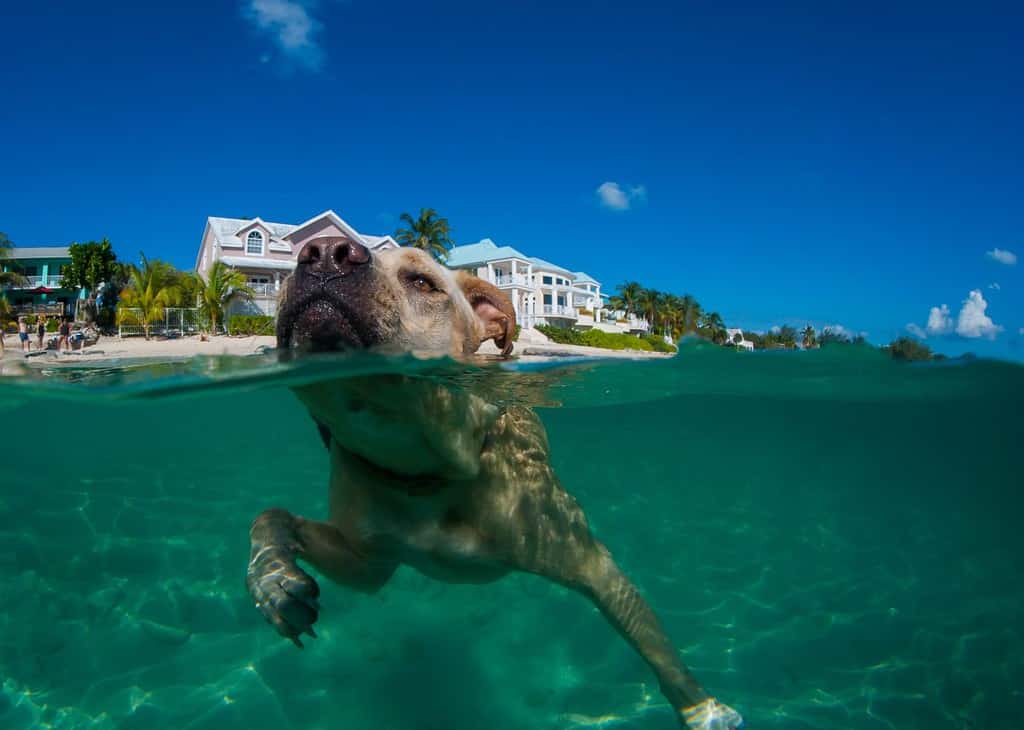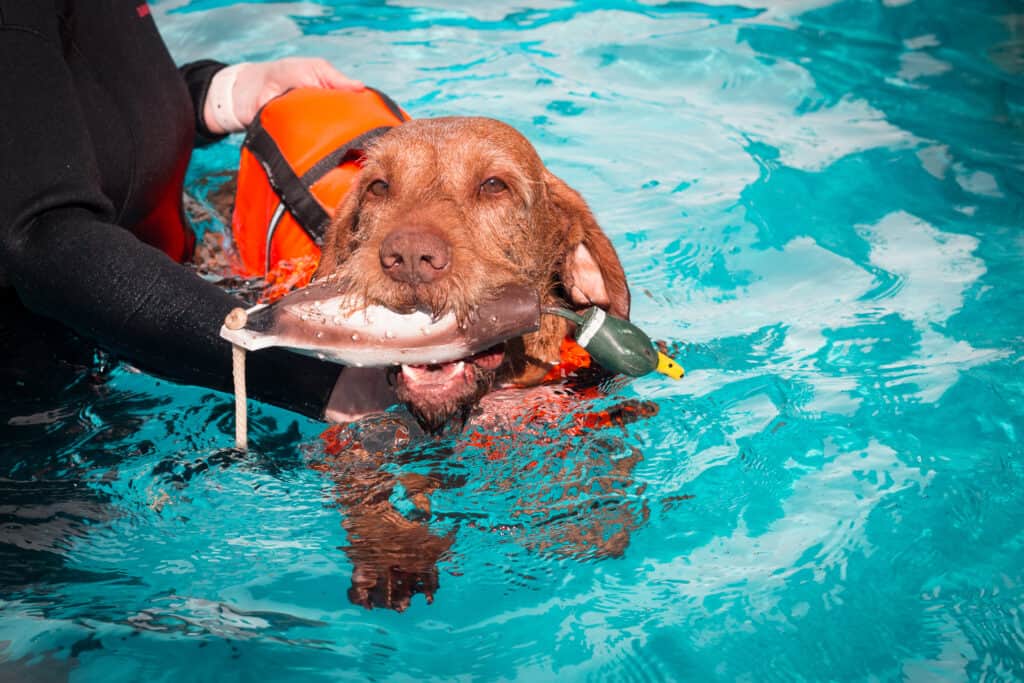Dachshunds are one of the most popular dog breeds in the United States. Since 2013, the American Kennel Club has released a “Most Popular Dog Breed” list. The list is based on AKC registration statistics, which means that it only includes AKC-registered purebred dogs. While that means that this list isn’t all-inclusive and can’t paint a full picture, it does still show a prominent trend. According to this list, Dachshunds have made the top 15 dog breeds every single year. These short-legged cuties have a hunting origin, but now most of them spend their days burrowing into blankets instead of animal dens. There’s a lot of cool stuff your dachshund can do, which is part of what makes this breed so popular. Can dachshunds swim? Yes! However, there are a few things you should keep in mind when taking yours to the swimming hole.
Not All Dogs Like Water

Dachshunds have a reputation for disliking water.
©Photobox.ks/Shutterstock.com
Regardless of breed, some dogs are quite water-averse. Some dog breeds are more likely to enjoy swimming – such as golden retrievers and German shepherds – but there is no guarantee that your dog will take a liking to the activity. Dachshunds, in particular, have a reputation for hating water. In fact, they’re on almost every list of “water-hating dogs” you can find. That doesn’t mean your dachshund will definitely hate swimming, but don’t be surprised if your pup is hesitant to dip their toes. If your dog doesn’t seem to like water, don’t use force. Use shallow water, positive encouragement, and a lot of patience. You may be able to acclimate your dog to enjoying swimming by displaying that it is a fun, rewarding, and optional activity.
Dachshunds Have a Unique Body Shape

Miniature Dachshund on a tree in English woodland.
©Owen Brown/Shutterstock.com
Most people can identify a dachshund easily. They have long bodies, strong barrel chests, and very short legs. Their bodies are built for hunting burrowing animals, such as badgers and foxes. Their skin is loose, their chest is strong for digging, and their low-to-the-ground build helps them track and burrow. However, this is not the ideal body shape for swimming. In fact, the proportions of dachshunds can make them sink easily. Their short legs are not ideal for paddling or propelling their bodies, and their heavy barrel chests are hard to keep afloat.
Dachshunds Wear Out Easily in Water

Despite their reputation, some dachshunds absolutely love the water.
©Margarita Storchay, Moscow, Russian Federation, Copyrighted free use, via Wikimedia Commons – License
One of the biggest things to pay attention to when taking your dog to swim is their energy levels. Dachshunds have a notable disadvantage in the water. This is due to their short legs and distinct body shape. Dogs with longer legs and slimmer torsos can physically adapt much more easily to swimming and sustain themselves in the water for longer. Even dachshunds that love swimming have this physiological disadvantage.
Even Strong Swimmers Can Struggle

Welsh Corgis like water though their little legs might not let them swim very fast.
©mdesigner125/iStock via Getty Images
Dogs have a hard time gauging their energy levels while swimming. Some dogs will keep swimming past their point of exhaustion and get in trouble. Always keep a close eye on your dogs while it is in the water. Be prepared to step in if your dog needs help. Look for signs that your dachshund is exhausted or struggling. These signs can include heavier breathing, struggling to keep head above water, choking or coughing, whining, trembling, increased splashing, and sinking back legs. A dog can go underwater in seconds, so it is important to always pay attention and make sure your dog is getting enough rest. Make your swimming pal take mandatory breaks between swims.
Use a Life Jacket

Floatation devices can save your dog’s life.
©Andy Gin/Shutterstock.com
Regardless of how proficient a swimmer your dog is, floatation devices are a great safety measure. Life jackets provide buoyancy to keep your dog safe and afloat. A flap on the life jacket holds their chin out of the water while the rest of the jacket provides even buoyancy across the rest of the body. Much like human life vests, they also have reflective portions to be able to more easily spot your dog. Look for a life jacket that correctly fits your dachshund and is equipped with a sturdy handle. It is important to guarantee the fit of the life jacket and to verify its quality by purchasing high quality and well-reviewed items.
Look for Potential Water Hazards

Rivers with strong currents are a safety risk for your dog.
©Kelly vanDellen/Shutterstock.com
Not all bodies of water are created equal. A variety of hidden dangers in seemingly-safe spots. Look for debris or contaminants in the water to prevent your dog from getting injured or sick. Avoid still or stagnant water, including many swamps and marshlands. Also pay attention to water currents and depth. A strong current in a river can sweep your dog away. A sudden drop-off can also be dangerous. Water temperature also impacts safety. Make sure the water isn’t too hot or cold for your pup. Other potential risks include boats, waves, blue-green algae, other swimmers, and a lack of easy access to the shore.
Make Sure There are Safe Entry and Exit Points

Dogs need to know how to easily get back on land after a swim.
©Drew McArthur/Shutterstock.com
It can be hard for dogs to exit the water in rivers and lakes. Make sure your dachshund can easily and safely enter and exit the water as it pleases. Dogs can experience fear, panic, injury, and death if they do not know how to safely get in and out of water.
Take Care of That Dachshund Coat!

Make sure to take care of your dachshund’s sensitive skin.
©neme_jimenez/Shutterstock.com
Dachshunds often have sensitive skin, which means they are more prone to skin problems. To avoid rash, infection, fur loss, and discomfort, make sure to rinse your dachshund off after a swim. Use clean, fresh water and avoid getting it in your dog’s mouth, eyes, or ears.
Bring Fresh Drinking Water

Hydration is crucial for dogs – especially when they’re being active.
©ALEX_UGALEK/Shutterstock.com
As we stated earlier, swimming is a pretty exhausting activity for your dachshund. It is easy for dogs to get dehydrated during a day on the water. Providing clean drinking water prevents dehydration. It also helps in preventing your dog from drinking the water they are swimming in, which might be unsafe for consumption.
Shallow Water is Best for Dachshunds

Shallow water is best.
©Shakarrigrafie/Shutterstock.com
The best places to let your dachshund swim are shallow and fresh water supplies. This includes creeks, streams, some lakes and ponds, and wading pools for dogs. Your dachshund will be much more comfortable in shallow water and there are a lot fewer risks.
Summary
If you want a swimming companion, a dachshund might not be your best bet. However, some dachshunds still do love to swim, and you can help them enjoy this awesome activity by taking steps to ensure their safety. We’ve summarized our safety tips below.
- Introduce your dachshund to water in fun and safe ways.
- Never force your dog to swim.
- Keep a close eye on your dog while it is in or around water.
- Stay close to your dachshund while swimming.
- Take frequent breaks from swimming to prevent exhaustion.
- Make sure your pup has a life jacket!
- Look for potential hazards in the water, such as debris, contaminants, and strong currents.
- Ensure safe points of entry and exit.
- Provide clean drinking water for your pup.
- Look for safe, shallow swimming spots, such as creeks, streams, and wading pools.
- Rinse your dachshund’s coat after a swim.
Remember that your dachshund isn’t physiologically built for the water. Unlike other dog breeds, this low-to-the-ground breed will always struggle more while swimming. As much as your companion may love to swim, you must be aware of the increased risks involved. Take extra care when exposing your dachshund to bodies of water and swimming.
The photo featured at the top of this post is © Tymoshenko Olga/Shutterstock.com
Ready to discover the top 10 cutest dog breeds in the entire world?
How about the fastest dogs, the largest dogs and those that are -- quite frankly -- just the kindest dogs on the planet? Each day, AZ Animals sends out lists just like this to our thousands of email subscribers. And the best part? It's FREE. Join today by entering your email below.
Thank you for reading! Have some feedback for us? Contact the AZ Animals editorial team.






